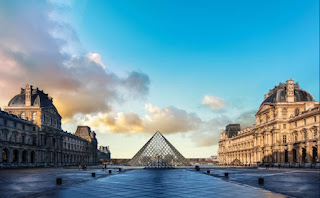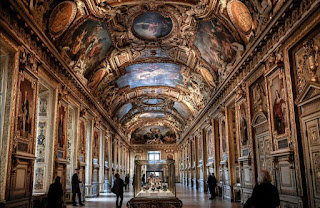The Louvre
The Louvre is one of the world's most famous and historic museums, located in Paris, France. Its history spans over eight centuries, and it has undergone numerous transformations and expansions.
Here's a brief overview of the history of The Louvre:
Medieval Fortress :
The history of the Louvre begins in the 12th century when King Philip II of France (also known as Philip Augustus) ordered the construction of a fortress in 1190 to protect Paris from Viking raids. The fortress was located on the right bank of the Seine River and was known as the Louvre Castle (Château du Louvre).
Evolution into a Royal Palace:
Over the following centuries, the Louvre was expanded and modified by various kings of France. It evolved from a defensive fortress into a luxurious royal palace. King Charles V (reigned 1364–1380) made significant additions to the structure, turning it into a more comfortable residence.
Renaissance and Architectural Transformations:
In the 16th century, during the Renaissance period, King Francis I (reigned 1515–1547) commissioned several architectural changes to the Louvre, adding elements of Renaissance design. He also brought in Italian artists and craftsmen to decorate the palace.
Establishment of the Art Collections:
The Louvre started acquiring art collections during the reign of Francis I. He purchased and collected various artworks, including paintings, sculptures, and decorative art pieces, laying the foundation for what would become one of the world's most extensive art collections.
Palace to Museum:
The French Revolution in the late 18th century led to significant political and social changes. The Louvre ceased being a royal residence and was declared a public museum in 1793 by the revolutionary government. It was renamed the "Musée Central des Arts" and opened its doors to the public, showcasing the former royal art collections.
Expansion and Development:
Over the 19th and 20th centuries, the Louvre underwent numerous expansions and renovations. Various architects worked on the museum, adding new wings and galleries to accommodate the ever-growing art collections. The iconic glass pyramid in the central courtyard, designed by architect I. M. Pei, was added in 1989 and became one of the Louvre's most recognizable features.
Modern-Day Louvre:
Today, the Louvre is one of the world's largest and most visited art museums. It houses an impressive collection of art and historical artifacts, spanning various civilizations and time periods. The museum's collection includes famous works such as the Mona Lisa, the Venus de Milo, and the Winged Victory of Samothrace, among many others.
Throughout its long and storied history, the Louvre has played a crucial role in preserving and showcasing the world's cultural heritage, making it a symbol of art, history, and human creativity.
Fact:
Largest Art Museum: The Louvre is the world's largest art museum and a historic monument. It covers an area of over 782,910 square feet (72,735 square meters) and houses around 38,000 objects in its collections.
Rich Art Collection: The museum's art collection spans from ancient civilizations to the 21st century, encompassing a diverse range of artworks, including paintings, sculptures, decorative arts, antiquities, and more.
Mona Lisa: The Louvre is home to Leonardo da Vinci's famous painting, the Mona Lisa, which is one of the most iconic and recognized artworks in the world. It attracts millions of visitors each year who come to see this enigmatic masterpiece.
Historical Artifacts: Apart from art, the Louvre also houses historical artifacts such as the Code of Hammurabi, an ancient Babylonian legal code dating back to around 1754 BCE.
Royal Palace Origins: The Louvre's history as a medieval fortress and subsequent transformation into a royal palace adds to its historical significance and charm.
Attractions:
Glass Pyramid: The glass pyramid, designed by architect I. M. Pei, is an iconic feature of the Louvre. Located in the museum's courtyard, it serves as the main entrance and has become a symbol of the Louvre's modernization.
The Venus de Milo: This famous ancient Greek statue of the goddess Aphrodite (Venus) is one of the Louvre's most celebrated sculptures. Its graceful and elegant depiction has captivated visitors for generations.
Winged Victory of Samothrace: This stunning ancient Greek sculpture of Nike, the winged goddess of victory, is displayed prominently at the Louvre. Its dynamic and dramatic portrayal is a must-see for art enthusiasts.
Rich Decorative Arts Collection: The Louvre's decorative arts section includes an impressive array of historical furniture, tapestries, ceramics, jewelry, and other exquisite objects that showcase the craftsmanship of various eras.
The Grand Gallery: The Louvre's Grand Gallery (Galeries du Louvre) is a lavishly decorated corridor that spans nearly 0.5 miles (0.8 kilometers). It houses an extensive collection of paintings, including works by masters such as Rembrandt, Vermeer, and Caravaggio.
Rich Egyptian Antiquities: The Louvre boasts an extensive collection of ancient Egyptian artifacts, including statues, sphinxes, hieroglyphs, and the stunning Sarcophagus of Ramesses III.
Temporary Exhibitions: The museum regularly hosts temporary exhibitions that focus on specific artists, art movements, or historical periods, providing visitors with fresh and diverse perspectives on art and culture.
The Louvre's combination of rich history, world-class art, and iconic architecture makes it an essential destination for art lovers, history enthusiasts, and travelers from around the globe.
Ticketing and visiting timings for the Louvre :
Tickets:
Advance Online Tickets: It is highly recommended to purchase tickets in advance through the official Louvre website or authorized ticketing partners. This allows you to skip the long lines at the ticket counters and secure your preferred entry time.
Timed Entry Tickets: The Louvre operates on a timed entry system, where visitors must choose a specific time slot for their entry. This helps manage the crowd and ensures a more pleasant experience inside the museum.
Free Entry: The Louvre offers free entry to certain visitors, such as individuals under 18 years old, EU residents under 26 years old, and people with disabilities and their companions. However, even for free entry, it's recommended to get a ticket with a designated time slot to avoid waiting in long lines.
Visiting Timing:
The Louvre's opening hours and visiting days were as follows:
- Monday : Closed (with some exceptions, as certain galleries are closed on Tuesdays instead).
- Wednesday to Sunday : The Louvre is open to the public during these days.







0 Comments